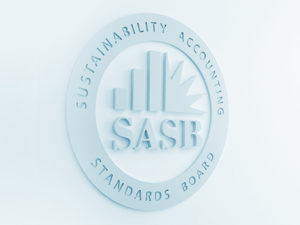An interview with Curtis Ravenel
Global Head, Sustainable Business and Finance, Bloomberg LP
SASB Foundation Board Member

Curtis Ravenel
Q: Bloomberg LP has been integrating sustainability into its products, services and operations for a long time, as a provider of Environmental, Social, and Governance (ESG) data on its Terminal, through its own corporate reporting as a private company, and in supporting SASB and other frameworks. What has been the motivation behind your leadership in this space?
A: The ESG factors included in the analysis tools on the Bloomberg Terminal, and the SASB metrics we have incorporated, both address material issues that are important to the investment, lending, insuring and research work of our clients. While we believe that ESG factors are an important part of running a successful and lasting business, ultimately, what drives the information that is on the Terminal is what our clients need for their day-to-day work.
Bloomberg was built on the notion that transparency in financial markets is essential for growth and stability, and transparency on ESG issues is no exception. As such, we have a responsibility to provide the private sector with the right tools and information to analyse ESG factors that can bolster market growth and improve risk management.
We lead with our own reporting because the ESG factors that impact our business are important to how we run our business, to our employees, our customers and other companies with whom we work. Reporting transparently about these factors as well as our overall sustainability strategy allows us to build strong, lasting relationships with each of these stakeholder groups.
Q: Does Bloomberg LP see itself playing a role in bolstering adoption of SASB standards?
A: Bloomberg is a founding partner of SASB and now that the standards have been published our work will only continue. As a global investment platform we have an important role to play in providing financial players with access to the information that corporations are reporting in line with the SASB standards. The ESG tools on the Terminal are incorporated into our full investment platform and the SASB indicators are integrated into our ESG company profile template. By using these tools investors can understand a company’s performance on key SASB metrics and corporations can better identify their own reporting gaps and compare to peers.
Proliferation of the SASB standards, which help translate material ESG issues into financial terms, will enable our clients to see how ESG factors can significantly contribute to their investment and risk mitigation strategies. Our work to further the global adoption of the standards through advocacy and use on the Terminal will help bring more transparency around these important issues and enable investors and lenders to place capital with the leading sustainable companies.
Q: How would you describe the value proposition of SASB standards to those in the European market?
A: Although SASB was founded in the United States, the work that SASB has done to identify ESG factors that have evidence of materiality does not stop at the US border. In fact, some of the factors may prove to be more material to companies outside of the US where issues such as climate policy changes or more extreme weather are more likely to occur.
In the globalized world in which we operate most companies, large or small, have operations, or customer and supply chains that span more than one country. Using one standard, such as SASB, globally will help businesses align internally on ESG issues. Not only can this help businesses achieve their ESG goals more efficiently, but it will also reduce their reporting burden and allow for a more targeted and transparent approach to investor engagement.
Companies in Europe who begin to use the SASB standards may be able to attract capital from US investors that are already more familiar with the reporting. European investors that utilise the standards for analysis and engagement can get ahead of requests from US asset owners for more standardised and transparent reporting on material ESG issues. What is more, in Europe, where further regulation on ESG reporting is on the horizon, the standards can be used to satisfy new regulation.
Q: What is your view on the harmonization of SASB with the framework put forward by the FSB Task Force on Climate-related Financial Disclosures (TCFD)?
A: Both SASB and the TCFD are getting a lot of market attention now and we want to make sure their alignment is clear to both companies and investors. Because it exists under the G20’s Financial Stability Board, the TCFD is a global organisation that takes a targeted approach at addressing one major ESG issue that is impacting global markets, climate change. It is not however, a technical guide on all aspects of accounting and reporting and it does not address all ESG issues. SASB can provide this technical guidance and will also help companies address other ESG issues that may be material to their specific industry. We believe that the harmonization between SASB and the TCFD will help SASB reach a global audience and it will help reduce the reporting burden for companies. Ideally, a company that reports in line with the SASB standards will also satisfy the TCFD recommendations.
Bloomberg LP is a Sponsor and Supporter of the 2018 SASB Symposium.


